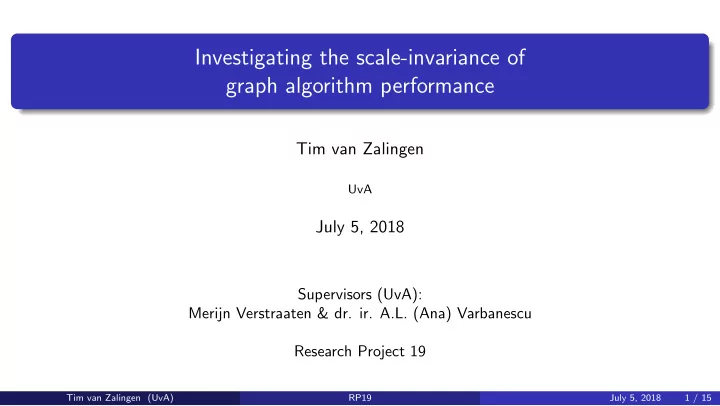

Investigating the scale-invariance of graph algorithm performance Tim van Zalingen UvA July 5, 2018 Supervisors (UvA): Merijn Verstraaten & dr. ir. A.L. (Ana) Varbanescu Research Project 19 Tim van Zalingen (UvA) RP19 July 5, 2018 1 / 15
Introduction Graph processing Figure 1: Example of a simple graph. Breadth First Search (BFS) Parallel Edge-centric vs vertex-centric implementation GPU Scaling Figure 2: Left: CPU architecture, right: GPU architecture. (source: nvidia.com) Tim van Zalingen (UvA) RP19 July 5, 2018 2 / 15
Scaling mechanism Figure 3: Original graph. Tim van Zalingen (UvA) RP19 July 5, 2018 3 / 15
Scaling mechanism Figure 3: Original graph. Figure 4: Sample of graph in figure 3. Tim van Zalingen (UvA) RP19 July 5, 2018 3 / 15
Scaling mechanism Figure 3: Original graph. Figure 5: Scaled graph comprised of two samples as shown in figure 6. Figure 4: Sample of graph in figure 3. Tim van Zalingen (UvA) RP19 July 5, 2018 3 / 15
Scaling parameters Number of interconnections High degree or random vertex bridges Sample size Topology: Figure 6: Chain Ring Star Fully connected Illustration of different topologies Tim van Zalingen (UvA) RP19 July 5, 2018 4 / 15
Research Question Is the relative performance of graph algorithms scale-invariant? What are the effects of tuning the scaling parameters? Do implementations show similar behaviour under scaling? Tim van Zalingen (UvA) RP19 July 5, 2018 5 / 15
Method Scaling parameters What parameters? Comparison of graphs Diverse set of graphs Scaled versions of this set Tim van Zalingen (UvA) RP19 July 5, 2018 6 / 15
Results: Scaling parameters - actor-collaboration Figure 7: Comparison between scaling parameters for the actor-collaboration graph. Tim van Zalingen (UvA) RP19 July 5, 2018 7 / 15
Results: Scaling parameters - dbpedia-starring Figure 8: Comparison between scaling parameters for the dbpedia-starring graph. Tim van Zalingen (UvA) RP19 July 5, 2018 8 / 15
Results: Graph comparison Figure 9: Comparison between algorithm mean computation time for different graphs. Tim van Zalingen (UvA) RP19 July 5, 2018 9 / 15
Vertex-push transition point Observation: The point where vertex-push starts to outperform other algorithm implementations, is in the hundred thousands of vertices. For similar graphs, is this transition point similar as well? Tim van Zalingen (UvA) RP19 July 5, 2018 10 / 15
Results: Vertex-push transition point All graphs are/have: Undirected Unweighted Average degree around 5 vertices/edges: ca: 6K/13K as-caida: 26K/53K AstroPh: 19K/198K loc: 58K/214K Figure 10: Mean execution time over scale on similar graphs. Tim van Zalingen (UvA) RP19 July 5, 2018 11 / 15
Discussion: Conclusion The relative performance of BFS implementations can be stable under scaling. However, it is not fully scale-invariant. Tuning scaling parameters has no great effect. Transition points and stability depends on the graph. The vertex-push implementation scales better. Results hint to a predicable transition point. Appears to depend on number of edges per vertex. Tim van Zalingen (UvA) RP19 July 5, 2018 12 / 15
Discussion: Limitations Effects of scaling parameters only investigated on two graphs. Set of graphs diverse and limited. Conclusions only valid for current implementation of scaling and BFS algorithms. Tim van Zalingen (UvA) RP19 July 5, 2018 13 / 15
Future work Investigate more graph algorithms. Compare similar graphs. Investigate variants of BFS implementations. Can transition points be determined? Tim van Zalingen (UvA) RP19 July 5, 2018 14 / 15
Summary The scaling parameters have low impact on how algorithm implementations scale. Relative performance is stable around a size. When scaling to multiple times the original size, algorithms can switch in ranking. Vertex-push appears to scale best. Tim van Zalingen (UvA) RP19 July 5, 2018 15 / 15
Recommend
More recommend